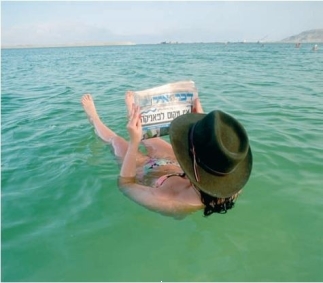A) salinity
B) temperature
C) both temperature and salinity
D) none of these
Correct Answer

verified
Correct Answer
verified
Multiple Choice
Salinity refers to _______ .
A) ocean thermal gradient
B) amount of sea life
C) salt content
D) all solid dissolved minerals
Correct Answer

verified
Correct Answer
verified
Multiple Choice
Consider the below image of a bather easily floating in the Dead Sea, exerting no effort to do so.  Why is it so easy for the sunbather to stay afloat?
Why is it so easy for the sunbather to stay afloat?
A) The thermocline is right near the surface and the temperature differential near her helps her to float.
B) The low water density in this region helps buoyancy.
C) The high biological activity produces gases to buoy her.
D) The high salinity in that body of water buoys her.
Correct Answer

verified
Correct Answer
verified
Multiple Choice
Feeding stages in the food chain are known as _______ levels.
A) pelagic
B) photic
C) trophic
D) epipelagic
Correct Answer

verified
Correct Answer
verified
Multiple Choice
Why is productivity low in tropical regions?
A) because the low density of the water makes it hard for plankton to float near the surface
B) because there is too much sunlight
C) because the deep waters are too warm to maintain a healthy biomass
D) because the thermocline acts as a barrier to the mixing of surface and deep waters
E) All of the above are problems.
Correct Answer

verified
Correct Answer
verified
Multiple Choice
_______ refers to the mass of all living organisms on Earth.
A) Food web
B) Biomass
C) Benthos
D) Trophic level
Correct Answer

verified
Correct Answer
verified
Multiple Choice
Examine the words and/or phrases below and determine the relationship among the majority of words/phrases. Choose the option that does not fit the pattern.
A) plankton
B) neritic
C) benthos
D) nekton
Correct Answer

verified
Correct Answer
verified
Multiple Choice
Organisms, such as algae and bacteria, that drift with ocean currents are known as_______ .
A) nekton
B) benthos organisms
C) biomass
D) plankton
E) none of these
Correct Answer

verified
Correct Answer
verified
Multiple Choice
The pycnocline is a rapid change in _______ with depth in the ocean.
A) salinity
B) density
C) temperature
D) biomass
Correct Answer

verified
Correct Answer
verified
Multiple Choice
Large Blue whales that are up to 30 meters long live primarily on _______ that is/are only about 6 cm long.
A) lobsters
B) fish
C) krill
D) squid
Correct Answer

verified
Correct Answer
verified
Multiple Choice
Productivity in the oceans is highest in_______ regions.
A) equatorial
B) middle latitude
C) polar
D) aphotic
Correct Answer

verified
Correct Answer
verified
Multiple Choice
The open ocean, regardless of depth, where animals swim or float freely is called the_______ zone.
A) pelagic zone
B) oceanic zone
C) intertidal zone
D) photic zone
Correct Answer

verified
Correct Answer
verified
Multiple Choice
_______ include all organisms that drift with ocean currents.
A) Nekton
B) Nerithos
C) Plankton
D) Benthos
Correct Answer

verified
Correct Answer
verified
Multiple Choice
_______ organisms live on or in the ocean bottom.
A) Scavenging
B) Benthonic
C) Planktonic
D) Nektonic
E) none of these
Correct Answer

verified
Correct Answer
verified
Showing 61 - 74 of 74
Related Exams